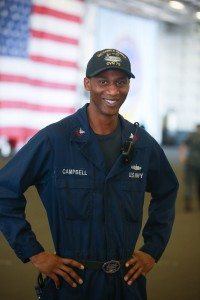By Lt. Ana Maring, Navy Office of Community Outreach
NORFOLK, Va. – A 2001 Dillon High School graduate and Dillon native is serving on one of the world’s largest warships, the U.S. Navy aircraft carrier USS Harry S. Truman (CVN 75).

Petty Officer 1st Class Marcus A. Campbell is a machinist mate aboard the Norfolk-based ship, a Nimitz-class nuclear-powered aircraft carrier and one of only ten operational aircraft carriers in the Navy today. Named in honor of former President Harry Truman, the carrier is longer than 3 football fields, at nearly 1,100 feet long. The ship is 252 feet wide and weighs more than 100,000 tons. Two nuclear reactors can push the ship through the water at more than 30 mph.
As a Leading Petty Officer with numerous responsibilities, Campbell said he was recruited into the Navy by his brother, Chief Petty Officer Matrell Lloyd. He added that he is from a small town and his grandma wanted to see him excel. “I saw things my brother was doing, the benefits he got plus I wanted to see the world,” said Campbell. “I plan to stay in until retirement.”
He also said he is proud of the work he is doing as part of the Truman’s 5,500-member crew, protecting America on the world’s oceans. “I’m working to get my aviation warfare pin,” Campbell explained. “My goal is to become a Chief Petty Officer.”
Sailors’ jobs are highly varied aboard USS Harry S. Truman. Approximately 3,000 men and women make up the ship’s company, which keeps all parts of the aircraft carrier running smoothly — this includes everything from washing dishes and preparing meals to handling weaponry and maintaining the nuclear reactors. Another 2,500 or so form the air wing, the people who actually fly and maintain the aircraft.
“I never cease to be impressed with the type and quality of work that goes on aboard Truman each day,” said Capt. S. Robert Roth, the carrier’s commanding officer. “Our team is filled with highly qualified young adults – in many cases, 19 and 20 years old – and they’re out here running a complex propulsion system safely, serving as air traffic controllers, operating sophisticated electronics, launching and recovering aircraft when we’re underway, and keeping this floating city alive and functioning. I can’t express how proud I am to be a part of this team. They performed at the highest level, day in and day out during our recent 9-month combat deployment and are continuing to do so here at home. Their professionalism, dedication and commitment to excellence are second to none.”
USS Harry S. Truman, like each of the Navy’s aircraft carriers, is designed for a 50-year service life. When the air wing is embarked, the ship carries more than 60 attack jets, helicopters and other aircraft, all of which take off from and land aboard the carrier at sea. Powerful catapults slingshot the aircraft off the bow of the ship. The planes land aboard the carrier by snagging a steel cable with an arresting hook that protrudes from the rear of the aircraft. All of this makes the Harry S. Truman a self-contained mobile airport and strike platform, and often the first response to a global crisis because of a carrier’s ability to operate freely in international waters anywhere on the world’s oceans.
As a member of one of the U.S. Navy’s most relied upon assets, Campbell and other USS Harry S. Truman sailors know they are part of a legacy that will last beyond their lifetimes.
“I would definitely recommend the Navy,” said Campbell. “I was a recruiter for 3 years. I would always tell people the Navy is like a regular job. You come to work, do what you’re told. If you have a hard head it will be hard. But I have a couple of sailors I recruited on the ship. It feels good when they tell you they are doing well. You put your mind to it, anything is possible.”


